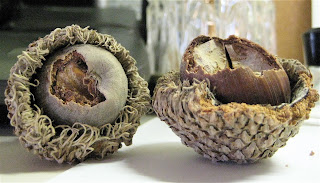Seeds need to travel in order to colonize new areas. If all the seeds fell at the base of the parent plant, there would be fierce competition for light, water, and nutritional elements in the soil. So seeds get dispersed using strategies that defy gravity, use animals and/or wind to travel to new locations.

Maple seeds are classified as samaras, which is defined as a dry, indehiscent (not opening at maturity along definite lines), winged fruit. If you throw maple samaras into the air they spiral down along a wobbly path. If there is wind I believe they can travel a fair distance before they hit the ground. Big-tooth Maple trees don't seem to make seeds every year. I don't know what conditions are responsible for seed production. It may be affected by the amount of rain or some other environmental factor, or it may be what their DNA is programed to do.

Many plants use the strategy that Buffalo Bur (Solanum rostratum) does which is to produce a seed with spikes which will get caught in the fur or feathers of a passing animal and travel with them. Eventually they will fall to the ground, and most likely will be far from the parent plant.

Antelope Horns (Asclepias asperula) milkweed produces a typical milkweed pod, which looks a little like a horn before it splits open. In this photograph you can see inside the pod where the seeds are lined up with their fluffy parachutes not open yet. To the right of the pod are some open seed carriers that are just waiting for a good breeze to arrive and carry them off with their seeds to a new destination.

Grasses evolved in open windy places and depend on wind to carry their pollen and many have fluffy attachments to their seeds. When the grass seeds are mature they loosen from the grass stem and are easily picked up by wind and carried off. This photograph is of Bushy Bluestem (Andropogon glomeratus) which has lots of fluffy attachments to catch the wind.

This photo is of some scat (animal poop) that contains seeds. Now, I don't know whose scat it is, or what plant the animal was eating, but these seeds are still intact, and will end up fertilized (in the right conditions). This scat is on a gravel road, which is not a good place for seeds to germinate, but if it was on soft ground and some rain fell on it, some of the seeds might start growing. So having animals eat their seeds and drop them somewhere else, is another way plants get their seeds spread around. Fleshy fruits that taste good to animals are especially well adapted to this kind of seed dispersal.
Tomorrow will be one year from the day I published my first post in this blog, "Welcome to the Bamberger Ranch Journal". When I started it I decided that I would publish one post each week which means that in one year 52 posts would be published.
This post is the 52nd. It has been a wonderful adventure for me. It has not always been easy to write a post each week, and because of cancer treatments I didn't always feel well. But I have learned so much and have taken lots of pictures. My friends that follow this blog say that they have learned to pay more attention to what is going on in the world around them. I have found that to be true for me too. I hope that you enjoy it and take the time to enjoy the world of nature around you!
I plan to continue for at least another 52 posts. If there is something that you'd like to know more about, send me a note in the COMMENTS section at the end of any post.








































